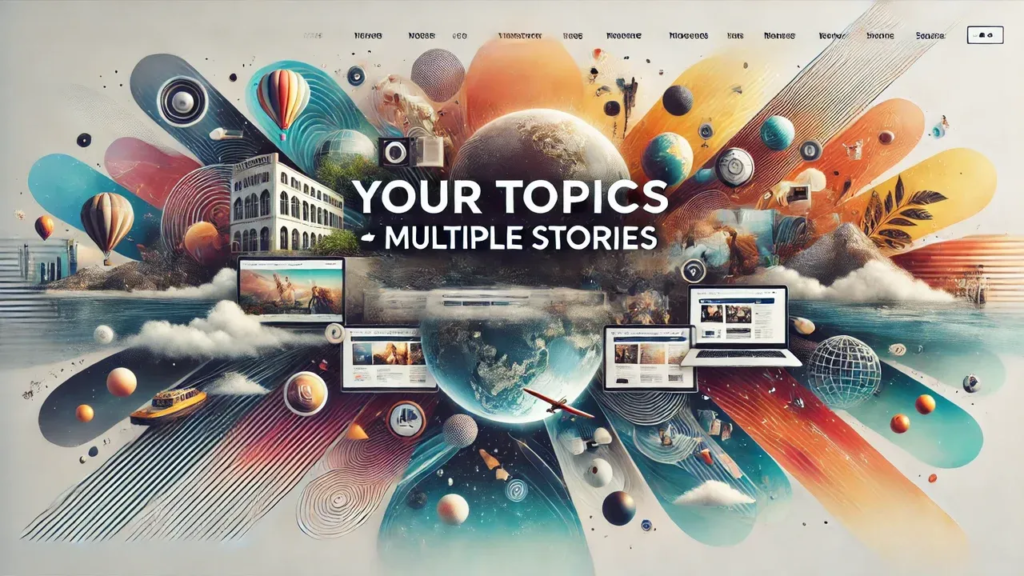Exploring Your Topics | Multiple Stories: A Journey Through Diverse Narratives

Introduction to Your Topics | Multiple Stories
Storytelling is a powerful medium that transcends boundaries, cultures, and time. It offers a unique way to explore various topics, allowing your topics | multiple stories individuals to convey complex ideas through relatable narratives. By leveraging multiple stories, one can delve into diverse subject matter, engaging the audience in a manner that captivates their attention and provokes thought. Storytelling not only enriches the experience of the audience but also enhances the understanding of the topics presented.
Examining different themes through a narrative lens can highlight the intricacies of a subject. For example, while discussing environmental sustainability, one might weave stories of individuals who have made impactful changes in their communities, illustrating the broader implications of their actions. Similarly, exploring mental health issues could involve sharing personal journeys that highlight struggles, triumphs, and the importance of your topics | multiple stories societal support. Each narrative provides distinct perspectives, showcasing the multifaceted nature of the respective topics.
Incorporating multiple stories into discussions helps foster a deeper connection between the subject matter and the audience. This engagement is essential in educational settings, where diverse narratives can enhance learning by presenting various viewpoints. For instance, addressing historical events through personal experiences can make history more relatable, allowing learners to appreciate the emotional significance behind facts and figures.
As we proceed, the exploration of topics will be enriched by the stories shared, illustrating not only the breadth of themes available but also the ways in which storytelling can bring these themes to life. Each narrative is a pathway, guiding us through the complexities of our chosen subjects, making them more accessible and memorable to your topics | multiple stories those who encounter them. The upcoming sections will showcase a range of diverse topics, each encapsulated in a compelling story that serves to inform, inspire, and engage the reader.
The Power of Storytelling in Different Fields
Storytelling has emerged as a foundational element across various fields, carving a unique space in education, marketing, and personal development. Each domain benefits distinctly from the art of narration, enabling profound engagement and comprehension.
In the realm of education, your topics | multiple stories storytelling serves as a powerful pedagogical tool. Instructors utilize narratives to present complex concepts, making information more relatable and engaging. When lessons are framed within the context of a story, students are more likely to remember and connect with the material. Techniques such as incorporating real-life examples or employing character arcs can enrich the learning experience. Educators can enhance their storytelling by leveraging visual aids or interactive elements, making learning dynamic and facilitating better retention of knowledge.
On the marketing front, storytelling has become a strategic asset. Brands that weave compelling narratives into their messaging can create emotional connections with their audience, effectively distinguishing themselves from your topics | multiple stories competitors. Marketers often employ techniques such as creating customer personas or showcasing testimonials to illustrate their brand’s story. By focusing on authentic narratives that resonate with consumer values and aspirations, companies can foster loyalty and trust. The integration of multimedia, including videos and social media storytelling, further amplifies reach and impact.
Similarly, in personal development, storytelling plays a crucial role in self-reflection and growth. Individuals can harness the power of their own narratives to shape their identity and drive change. Techniques such as journaling or sharing experiences in group settings can facilitate personal insights and connections. By reframing their stories, individuals can challenge limiting beliefs and inspire themselves toward their goals. This emphasis on personal storytelling underscores its importance in fostering resilience and self-awareness.
Overall, the versatility of storytelling across diverse narratives offers numerous benefits. By applying targeted storytelling techniques within each field, individuals and organizations alike can enhance communication, deepen connections, and inspire change.
Showcasing Multiple Stories: Real-World Examples
In the realm of storytelling, the diverse narratives found within “your topics | multiple stories” serve as a powerful means of conveying complex ideas and fostering deeper understanding. By examining several compelling examples, we can appreciate how distinct themes intertwine, providing both inspiration and insight.
One notable example is the initiative undertaken by a community organization aimed at improving literacy rates among underprivileged children. This project narrates the experiences of educators who implemented innovative teaching methods, integrating technology into their classrooms. By sharing personal anecdotes of triumph and struggle, these your topics | multiple stories educators painted a vivid picture of how varied educational approaches can yield positive outcomes. This project not only showcases the individual journeys of teachers and students but also highlights the overarching theme of educational equity.

Another instance can be your topics | multiple stories observed within the environmental movement. A series of case studies detailing community-led conservation efforts illustrate how ordinary citizens can enact change through storytelling. For example, a coastal community organized a campaign to protect mangrove forests, emphasizing the importance of preserving local ecosystems. By documenting the personal stories of residents and their connection to the land, this narrative exemplifies how individual experiences contribute to collective action, encouraging readers to reconsider their relationship with the environment.
Finally, the realm of entrepreneurship offers a wealth of narratives demonstrating the power of resilience and innovation. A startup that pivoted its business model during a crisis effectively showcases how adaptability is central to success. The founders’ reflections on their journey illuminate the intersection of personal sacrifice and your topics | multiple stories professional growth, providing valuable lessons to aspiring entrepreneurs. Through these stories, we see how various elements such as perseverance, creativity, and collaboration come together to create impactful outcomes.
These real-world examples not only illustrate the concept of “your topics | multiple stories” but also serve as an encouragement to readers to explore their own narratives and the potential interconnections that exist within them.
Tips for Crafting Your Own Stories
Creating compelling narratives requires a blend of creativity and strategy. To successfully craft your own stories related to your topics | multiple stories, begin by understanding your audience. Consider who you are writing for—what are their interests, backgrounds, and values? This foundational step will guide the tone and content of your narratives, ensuring they resonate with readers and spark their interest.
Next, develop a unique voice. Every storyteller has a distinct style that sets them apart; this is an opportunity to express your personality through your writing. Experiment with different tones, from conversational to formal, and find what feels most authentic for you. A genuine voice will enhance your connection with readers, making them feel more invested in your tales.
Structuring your narratives is another crucial facet. A well-organized story often follows a clear arc: introduction, rising action, climax, falling action, and resolution. This structure helps maintain the pace and allows for tension to build, keeping readers engaged. Be sure to introduce elements of conflict—whether internal, external, or both—as this drives the narrative and provides depth to characters and situations.
Incorporating emotion is vital for engagement. Whether it’s joy, sorrow, or anxiety, emotion allows readers to relate to your characters and their journeys. Use descriptive language that evokes feelings and paints vivid images, immersing your audience in the experience. Don’t shy away from vulnerability; sharing personal insights often resonates with readers on a profound level.
By thoughtfully considering your audience, refining your voice, structuring your narrative effectively, and weaving in emotional depth, you are well on your way to creating stories that illuminate your topics | multiple stories and connect with others in meaningful ways.



